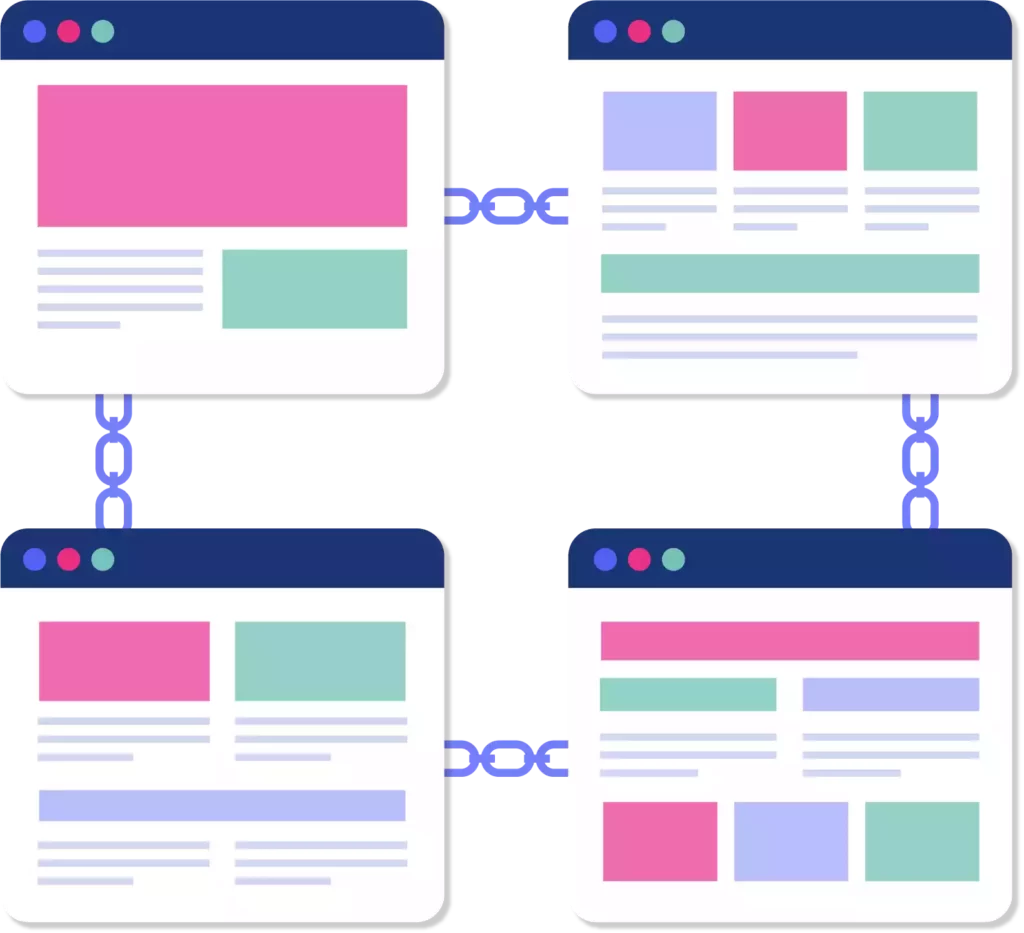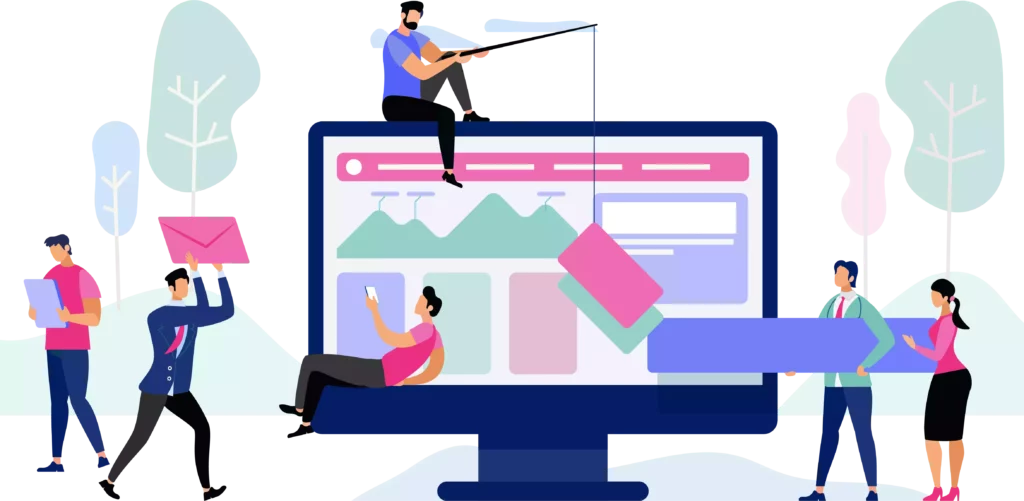Off-page SEO
What is Off-page SEO?
We have learnt about optimizing the content, speed and structure of the website etc., but that isn’t enough if it doesn’t get the necessary recognition in the first place, right? So, everything you do as the owner of a website, outside the site to drive user traffic is referred to as OFF-page SEO.
Link building, social media marketing, local SEO are some things among others that categorize as Off-page SEO. It helps generate the right kind of user traffic to your website helping your progress up the ladder on SERPs.
To be able to understand and implement better, let’s understand these concepts individually.
Backlinks – An Introduction

Backlinks are a link to another relevant site embedded in a website to help the visitor find more resources relevant to their search. Pages that have a higher number of backlinks tend to scale up on the organic search results.

Why are backlinks important?

Well, because they tell the search engines that the content in that site is valuable, useful and credible. And these are major factors that a user looks for in a site. While writing quality content helps you rank better, getting a few relevant sites that link to similar content increases your chances of ranking higher. So, backlinks are basically votes that you get and the higher the number of votes you gather, the higher you will rank in SERPs.
Backlinks can be largely classified as natural links, manually built links and self-created links.
Natural links are ones that the owner has given from a personal point of view. For example, if the article talks about their favorite organic food or drink, then there are chances of them leaving a link to their personally preferred brand that produces the same.
Manually built links are more a part and consequence of deliberate link building exercise often practiced by several website owners. Examples include getting users to link your website via reviews etc., or asking someone with significant influence to promote your content.
Self-created links are often embedded in an online forum, directory etc., although some may tend towards black hat SEO practices. So that is a dicey one.
Link Building

Now that we have understood that links are an absolute essential part of SEO, here are some helpful pointers on how to build effective links.
Link building is essentially the practice of building one-way hyperlinks to a website to increase its visibility to search engines. Some common practices include content marketing, building useful tools that allow link building, reaching out through emails and public relations (PR).
Now if one is committed to link building which is the core part of OFF-page SEO, they are bound to find 100 ways to do it. So here are some effective ways to build links.
1. Citations
Social media provides a huge and effective platform to users to mercilessly use it to their advantage. So use it! Attach target website links on all your social media platforms in the about or bio section, on the website business pages and personal ones too according to preference.
List your business on local listings or citations on Google even if it isn’t one.
List yourself on general directories and classifieds that list businesses, markets and services because a lot of users often run down the lists looking for services. It holds a potential customer/user base for you.
Ex:
2. Internal Linking Tactics
This is effective in boosting the organic traffic to the website. Internal linking are hyperlinks that redirect users to a relevant talking point that is covered by the same website. In simple words, an internal link points you to another page on the same website.
This tactic holds potential because it means killing two birds with one stone. That is, the benefits of this technique include:
I. passing authority from one page to another improving search optimization.
II. guide visitors to high-value, high-converting credible sources of information, referred to as usability.
III. Prompt users to take the desired call to action by providing llinks that help them do it right away – referred to as conversion optimization.
Quite the effective tactic, isn’t it?
3. Link Begging
The name says it all! How do you get links directed to your website? ASK! One way to do that is to ask people directly to link your site from theirs. People do so by sending mails, making phone calls or leaving people a message on social media platforms like Twitter and Facebook.
It seems pretty direct but hey! It works, so win-win!
Cold outreach emails are ones that are exclusively sent out for such purposes. Google similar websites, podcasts, blogs etc., and find out if the owners link up other such people and websites. If they do, ask them to do it for you. Now just asking for favours rarely is ever fruitful. So be smart and offer an incentive like cross promotion or sometimes, offering money works although that isn’t the healthiest way to go.
Here’s an example of a cold email:
Hi ______(Find webmaster name),
I am currently promoting my blog on pain relief foods and as a passionate new blogger in the field, I understand that I need to get authoritative blogs like yours to link to mine.
I apologise for contacting you directly via email, but in exchange, I am happy to promote your blog on my YouTube channel, Twitter, podcast, Instagram or anywhere else.
(Optional) I also have a small budget so I can pay for some promotion. Is there anything that you are currently working on that I can help you with?
Sincerely,
Hacks of a Healthy Lifestyle,
Your Url Link to social channel 1( same as blog link to pain relief foods)
Link to social channel 2
7. Guest Blogging
Guest blogging or “Guest posting” is the act of writing content for other websites or company websites. Generally, these content writers act as guest bloggers for websites that are similar to their own so that they can attract traffic to their website.
What they do is, write content for others whose ideas or content aligns with their own and add their own website links as plugins or backlinks which helps the SEO of their website. Although this doesn’t happen as often anymore, people still guest-post on websites that are well established.
Here’s an example of an email request for guest blogging:
Subject of email: I’d like to guest-post or advertise on your blog
Body of email:
Hi ____FirstName____, I run a website XYZ which helps cats have happier lives.
I am currently working hard on promoting my site. When I researched promotional partners, I came across your blog, and felt that it would be fantastic to get a mention from your site.
I would be thrilled if you could mention my site to your audience, especially on your blog since I am actively doing SEO.
In exchange, I am happy to promote your site on my social media, email list, YouTube channel, or help in any way that you might find useful. (I can also pay for promotion if that works for you)
Would it be possible to partner with you that way?
Thanks,
MY Dr.
4. Google SEO trends
5. Getting Links on Wikipedia
Wikipedia articles sometimes include links to articles outside it, external links. Links normally shouldn’t be placed in the content part of the article and should only be included if its inclusion can be justified according to both the guidelines and common sense.
As long as it makes sense, here’s how you can add a link on Wikipedia:
6. Avoid Keyword Stuffing
Using target keywords or keyphrases is important because that helps the search engines detect what your content is all about and an optimum use of keywords even helps your website rank better. BUT, that said, overusing the keyword or “stuffing” it in your page in hopes of better ranking is simply futile. Although less often, some brands still do it to boost their search engine visibility. Keyword Research helps you get a better picture of the whole thing.
Some ways in which keyword stuffing is done but shouldn’t be:
1. Unnecessary repetition of words and phrases
2. Incorporating words that are out of context
3. Inserting blocks of the same keyword
Here’s an example:
“If you’re looking for the best laptop bag, look no further. Our brand offers the best laptop bag that you could want for business or pleasure. With padding in our liners and a special pocket for your charger, this is the best laptop bag for travel or school.”
Things To Remember
1. The Anchor Text
Anchor texts are HTML tags that are used to define the beginning and ending of a hypertext link. They are used by search engines to determine the subject matter of the destination URL. The anchor text is used to reach the target link by users.
There are a few types of anchor text that help make it effective:
I. Exact-match: If the anchor text includes a keyword that mirrors the page it is linked to, it is called Exact match. Ex: ‘link building’ leading to a page that talks about link building.
II. Partial-match: If the anchor text includes a variation of the keyword, for example: ‘link building strategies’ linking to a page about link building, it is referred to as partial match.
III. Branded: When brand names are used as anchor text, for example, ‘Moz’ linking to the Moz website blog.
IV. Naked link: Pretty much conveyed through the name, when a URL is used as the anchor text, like ‘www.moz.com’, it is called a naked link.
V. Generic: Generic anchor texts include phrases like ‘Click here’.
VI. Images: Google uses the alt text attribute of the image as an anchor text.
2. Link Relevancy
This is a major one. So, Google analyzes anchor text, inbound links and outbound links and meta description– immediate description surrounding the title that talks briefly about the article, to judge the content of the website/page. Fair enough. This makes it an important rank determining factor.
3. No Follow vs Follow Links
The technical difference between a nofollow and dofollow link is that the nofollow link has a nofollow tag and as a user we cannot tell the difference whatsoever. But, only dofollow links are counted in a search engine’s algorithm. According to Google, nofollow links do not pass any standard for PageRank.
Ex: Follow: <a href=”example.com/”> Example </a>
No Follow: <a href=”example.com/” rel= nofollow> Example </a>
The illustration below shows how much dofollow links benefit in terms of SEO.
Backlinks – Quantity Or Quality?

Links are what glue the whole world of the internet. Getting links that are of real value in terms of content goes a long way in gaining credibility and hence user traffic. They form a core and important part of off-page SEO and it all boils down to building the right kind of links. A website that has higher value backlinks stands a better chance of ranking higher than one with fewer backlinks.
And the answer to the title of this section is, without a doubt, quality! Unless you have some really useful links with information, stick to quality and an optimum number of links. Because when there is quality, your page will automatically receive a lot of clicks and improve your SERP ranking.
Research what backlinks your competitors are using and use them or find good ones along those lines. Keep your website backlinks updated. Revisit your older pages and update the backlinks used to newer, better informed pages.
Being mindful of the content you are creating and putting out there along with the kind of content you are sharing will go a long way in helping your website rank higher and stay there in the long run. Choose quality over quantity.
Generating Backlinks and the Best Sources

If you’ve come this far, you have a fair idea of what kind of links really make your website a preferred one. So, here are some tips & tricks that will help you get the links best suited for your website and sources where you can get them.
1. Stay up to date on the news. Now you don’t have to know every move of the world but a rough idea will help you find your opportunities. And when there’s news that is relevant to your site, jump in and create an opportunity for your website to shine! Turn on those google alerts and stay up to date.
2. Identify a piece of content with a proven track record of generating links. Create something even better. Focus on thorough and up-to-date content and a well designed site/page is the way to go.
3. Reach out to the right people, ones in your domain, ones interested in your domain or ones that have previously linked other articles in their website.
Or, reach out to them with valuable insights from your experience or industry that is relevant to them and include credentials. Another way to do it is to watch out for events/people coming up with potential opportunities where you can offer your content to them for their benefit. Just keep doing and find ways to act fast so that you don’t miss an opportunity.
Websites like ahrefs, Majestic SEO, backlinko can be used to find the necessary keywords, keyword traffic and backlinks for the same.
Optimizing Backlinks (delete this heading and just merge it with the generating backlinks thingy)

Take part in Crowdsources Posts
These can lead you to receiving a significant number of backlinks. More often than not people ask you about things you already know. So unless you are swamped with work, do agree and contribute.
(couldn’t find an example apart from this)
List out Some Effective Tips & Tricks
People are more likely to click on a list format info than others. Massive ones again might tend to lose the readers’ interest midway. So find a smaller compact sized list with valuable tips or information that will earn you a link or a loyal user.
Find Pages That Sell
Whatever domain you are into, find retailers or organizations that deal with your topics. Reach out to them and share your content so that they add you on their list help you become more visible. This is a big one for local businesses.
Revisit & Fix
If you have been doing this for a while, you might have a few outdated or broken links that point to your site, so revisit them and fix them. You can use ahrefs to find broken links: “Backlinks à Broken”. And voila! You have a few more backlinks with no investment of any sort.
Basically, as a parting note, here’s a secret. Off-Page SEO is reliant on how humans behave. You will only recommend products that you like, to your people. And that’s the way it works with Off-Page SEO too.
So improving the website in a way that impacts the users’ and search engine’s perception of it is the way to go! And that is the reason why backlinks are important as well. Because recommendations are like testimonials and that makes your website trustworthy. It could be mentioning your brand/website, sharing them or simply appreciating it which counts as votes of confidence. It all adds up to building your website’s image and that is crucial to the growth of the website.
We hope this blog provided some insight and was of value.
Deleted Part
Honestly, the best answer to everything most times! Google! Research and find out what’s working right now. This is a great source of exposure as to what your counter-parts are doing to boost their Off-page SEO.
Although we work and are on laptops all the time, most people tend to spend time scrolling on the phone and that is when most searching happens. When people chance upon your website or visit intentionally, their experience matters! A lot! So the speed, readability, content value and credibility matter and mobile UX determines your ranking to a large extent.






